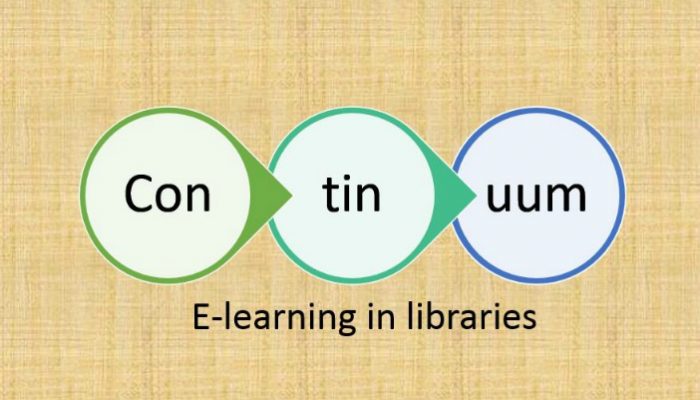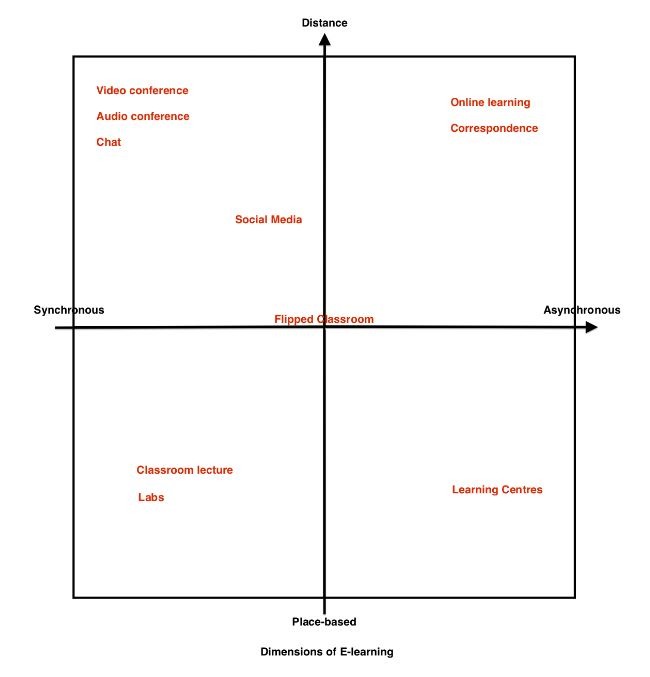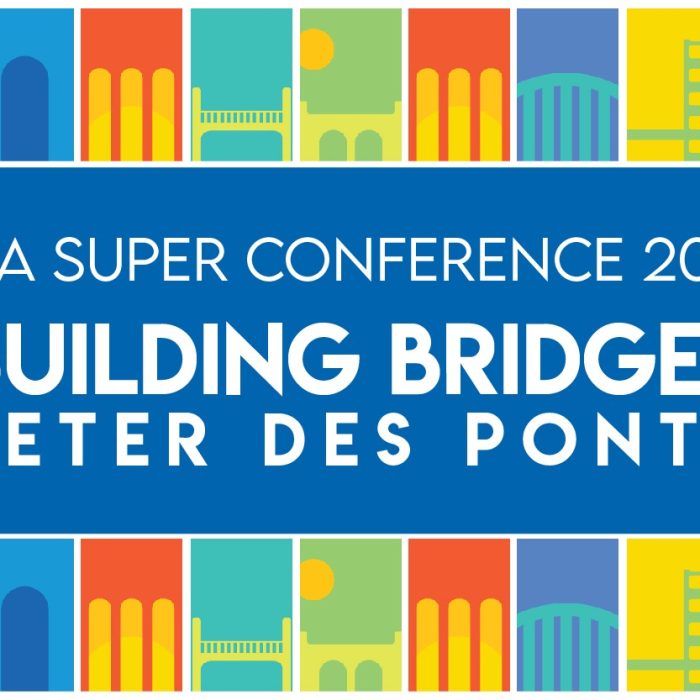Learn about the benefits of constructing a multi-year internship from a MLIS student's perspective.

What is e-learning in libraries?
Technology is changing the way we do nearly everything, from driving our cars to experiencing (virtual) reality, right down to the way we learn and teach. Our new Continuum column dives into the e-learning waters by addressing a spectrum of issues including the nature of e-learning, the role of technologically-informed teaching and learning in library work, and the resources that are needed to make e-learning happen.
In this first column, Continuum author Kasey (Mallen) Whalley takes on the challenge of defining e-learning in libraries with guest columnist Mark Bullen, an adjunct professor in the Master of Educational Technology program at the University of British Columbia.
What is e-learning?
E-learning is now a reality in many learning environments in Canada. With the development of new technologies in and for the classroom, school and academic libraries are in a position to actively and effectively support these changing pedagogies. But what is e-learning and can we say that e-learning is happening just because learners and teachers use technology?
Mark Bullen (MB)
In fact, there is some debate and even fuzziness about how e-learning is defined. This lack of consensus as well as clarity is significant because it could lead to missed opportunities—if we aren’t clear about what e-learning is, then how can we make full use of its potential as an approach to learning and ultimately enhancing our services. So what is e-learning?
One of the most important things to understand about e-learning is that it is not just one thing. It has many dimensions and applications and can be used in many different ways, from supporting teaching and learning in the classroom to providing fully online distance education. E-learning is best viewed as part of a teaching and learning continuum that begins with face-to-face teaching without the use of information and communication technologies (ICT) at one end and fully online distance learning at the other end.
As we move along the continuum from fully face-to-face teaching, technology is used to replace the face-to-face elements. Initially, this has very little impact on how teaching is organized and how learning occurs because the technology is used primarily to enhance the face-to-face teaching. But as we move further along the continuum, the nature of teaching and how it is organized is increasingly affected by the use of ICT. Somewhere around the middle of the continuum we have what is called blended learning or the “flipped” classroom.
In a blended environment, fewer face-to-face sessions are held as technology is used increasingly to deliver the teaching and to facilitate the learning. And nature of the face-to-face sessions changes. Instead of coming to class to listen to a teacher, students come to discuss, and to work and collaborate in small groups. Once we reach the right end of the continuum there is no longer any face-to-face teaching and we have fully online learning in which all teaching is technology-mediated. E-learning is that part of the continuum that begins when technology is used to replace some of the face-to-face teaching to the point on the continuum where it replaces it all.
E-learning: From replacing some face-to-face teaching to replacing it all
It’s also important to understand the relationship between e-learning and distance education. These days distance education is primarily delivered online but historically it has used other technologies and there is still a considerable amount of distance education that would not be considered e-learning. So there is what we could call blended e-learning in which there are some face-to-face sessions but most of the learning is done online, and there is distance education e-learning in which all teaching and learning is done without teacher and learners ever meeting face-to-face. And there is distance education that is primarily print-based and would not be considered e-learning.
But the single e-learning continuum doesn’t capture e-learning fully and it may be more helpful to think about it in terms of two critical dimensions, each with its own continuum: distance and synchronicity. The distance continuum spans place-based learning and teaching to fully distance teaching and learning and the synchronicity continuum spans real-time interaction to completely asynchronous interaction. If we think about these as two axes on a graph we can then place the different implementations and applications of e-learning on it (see below).
Kasey (Mallen) Whalley (KMW)
The graphic above is a fantastic way to understand the complexities of defining e-learning. For public school libraries, and some academic libraries, encountering all or none of these implementations and applications is an ongoing reality—it creates a trend of defining e-learning by the shape it takes in our schools. If school and academic libraries look at the whole e-learning picture, they can get lost in what could be and not what is e-learning at their institution. This means, for some school and academic libraries, e-learning is defined by the digital tools and applications through which it happens: The learning management system, the online forums, or the digital literacy initiatives happening in individual schools.
E-learning becomes contextualized, and libraries work with the teachers to support e-learning as it exists in their educational institution. This doesn’t mean, however, that library professionals are blind to the possibilities of e-learning, as many of us work to be knowledgeable about the big e-learning picture, and support new e-learning initiatives brought forth in our schools.
Libraries as e-learning spaces?
Learning happens in many different contexts and environments: Home, work, school. Certainly school and academic libraries seem to fit naturally with ideas about where classrooms “live.” Now, we can’t boil this article down to a how-to, since certainly school libraries (public and academic) will require different needs, have different resources, and will involve the library and library staff in different ways.
However, we can start to evaluate how libraries can best support the needs of staff and students engaged with e-learning methodologies in a broad and critical way.
KMW & MB
Certainly, (public) school and academic libraries can support e-learning approaches by:
- Developing meaningful digital literacy programs.
- Digital literacy is the ability to effectively use and communicate information with digital technologies. This means understanding how digital technologies work, using it to find and evaluate information, create something new, and communicate clearly. From understanding how to use the messaging app on your phone to coding a messaging app for a phone, digital literacy covers a wide range of topics related to information and communication technologies. Libraries are actively tailoring programs to meet these needs at all ages and literacy levels.
- Becoming involved and embedded in e-learning programs and classrooms.
- Being embedded and involved can be achieved by adopting blended learning approaches by teaching both face-to-face sessions and following up with announcements to students through our learning management system (LMS), working closely with classes on specific assignments delivered online or digitally to provide meaningful reference services, or participating in learning technology/e-learning committees to better understand trends at your school .
- Actively looking to support e-learning initiatives within our schools in relevant ways.
- Reaching out to classes and teachers who are delivering content online and seeking ways to support these initiatives, such as increasing library content through the LMS or online forum for that assignment
- by having standard “plug-ins” such as a link to our provincial virtual chat program in individual courses for academic libraries
E-learning in libraries as digital literacy
As data and digital technology continues to become more and more a part of our everyday lives, digital literacy has necessarily become a large part of library programming—across sectors.
KMW
Within schools and other learning environments, this has meant that libraries have responded with initiatives designed to increase the digital literacy of students and staff:
- Makerspaces, including access to 3D printers
- Digital workshops
- Technology showcases
The increase of e-learning initiatives in public schools and post-secondary institutions means libraries need to develop programs and services designed for digital literacy, i.e., programs that move beyond siloed information delivery of a particular e-learning platform, by integrating and contextualizing e-learning in the broader digital literacy landscape, staff and students can begin to understand how these seemingly disparate parts are actually incredibly intertwined.
As such, library staff need to develop programs and services that effectively and iteratively educate and explore digital literacy issues for students and faculty at the microcosm of our schools, and the macrocosm of the digital world. To put it more concretely, school and academic libraries are in position to offer workshops, programs, and services that directly respond to privacy, collaboration, cognitive load, and other emerging and ongoing issues regarding digital technologies which can enhance and underpin classroom e-learning tool usage.
MB
I agree that libraries should be playing a central role in helping educational institutions respond appropriately to the growing importance of digital technologies in education. Libraries are an ideal location for this kind of support to be centered because digital technologies in education are fundamentally about accessing, assessing and using information and library staff have the skills to support this activity.
It is important, however, that libraries provide this support as part of an overall institutional digital strategy that spells out the goals and methods for achieving those goals and clearly articulates the responsibilities of different parts of the organization for providing the necessary support. Students, faculty and staff need to know who is providing what kind of support so there is no confusion.
Library professionals as e-teachers
KMW
I agree: Being clear about our responsibilities is important for reducing confusion for students. This can be further emphasized by having library professionals embedded or engaged with the e-learning programs at our schools as members of the team, with a specific role. Libraries are busy, happening places, but offering to be embedded or involved with e-learning initiatives at our institutions means that we are in a good position to help staff and students navigate resources necessary for their courses.
Library professionals need to engage meaningfully with students in the adoption and use of e-learning platforms, even if we aren’t directly involved with the program or course. Helping students make parallels and connections, appointing student leaders or hosting student training sessions, and providing ready reference services about e-learning platforms and initiatives allows us to not only increase digital literacy at our schools, but keeps us in touch with the changing educational landscape in which we are situated. Reaching out to faculty, being an informal sounding board, or officially sitting on an e-learning committee are practical and important ways that library professionals within educational institutes are able to get involved, and work to be embedded with e-learning initiatives and programs at their schools.
MB
Yes, library staff need to be included on course development teams for online programs and represented on on institutional e-learning committees. Too often, the provision of library resources for online courses is something that is left to the last minute or overlooked completely. If library staff are involved from the outset they can not only help locate valuable resources for the course being developed but also advise on the kind of support that they can provide to students once the course is underway. This information can then be built into the course with direct links to library services.

Teaching, learning and reflection
KMW
One of the best ways libraries can support e-learning initiatives at their schools is to be engaging critically with these practices in a reflective and relevant way. This, above all, means knowing your school, staff, and students, and responding to their needs in meaningful and applicable ways. At some schools, the library might be the touch point for digital technology and e-learning training, while at others this may fall to a different department. Some schools may have a variety of platforms to support e-learning initiatives, while some are exclusive to only one. Resources and budgets are always a discussion point when introducing or continuing library programs, and e-learning initiatives could be dealing with those same concerns.
As library professionals, it’s our responsibility to respond to these considerations in a critical and thoughtful manner that best reflects our organization, our goals, and our roles within the school. Understanding the need for early adoption, the ongoing challenges of new technology, and emerging trends in e-learning platforms means we are able to help support these initiatives, both contextually in the broader scope of e-learning needs, and specifically for the platform(s) at our individual schools. It’s imperative that libraries remain aware and engaged with the changing digital needs of our staff and students, and respond in practical, applicable, and reflective ways.
MB
I think the two key words you touch on here are “critical” and “reflective”. Too often technology decisions are made because there is a sense that the organization will be left behind if it doesn’t embrace the lastest new, new thing. Technology decisions need to be evidence-based and driven by the needs of faculty and students. Library staff can help provide a critical and reflective analysis of new technology developments and temper some of the techno-utopic frenzy that can otherwise drive decision-making.
Final thoughts
KMW & MB
Developing dynamic and proactive digital literacy programming, becoming involved and embedded in e-learning initiatives, and responding critically to emerging and ongoing e-learning programs within our schools will allow libraries and library professionals in educational intuitions to be allies in our changing pedagogies.
As technology continues to change some parts of how we teach and learn, school libraries will need to respond in innovative and thoughtful ways to ensure that we continue to support the educational needs of our staff and students.
Written by Kasey (Mallen) Whalley and Mark Bullen
Kasey (Mallen) Whalley has been working in and with libraries for over ten years. After completing her undergraduate degree in English from McMaster University, she immediately enrolled in and completed Seneca College’s Accelerated Library and information Technician program. She is currently employed as a Library and Information Technician with the Dufferin-Peel Catholic District School Board. She can be contacted at kaseywhalley [at] outlook.com.
Dr. Mark Bullen is an adjunct Professor in the Master of Educational Technology (MET) program at the University of British Columbia. He was centrally involved in the development of the MET in 2002 and has been teaching Planning & Managing Technologies in Higher Education (ETEC 520) since then. He can be contacted at mark.bullen@ubc.ca


